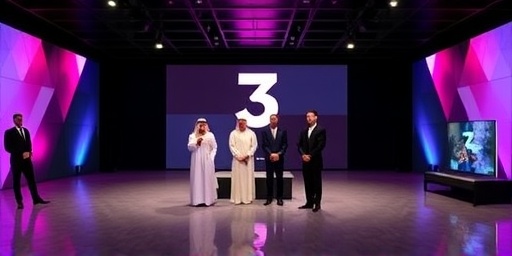In a landmark expansion that promises to redefine visual storytelling in the Middle East, Company 3, the renowned US-based post-production and VFX powerhouse, has inked a pivotal partnership with Media City Qatar. This collaboration will birth a state-of-the-art visual effects studio in Doha, positioning Qatar as a burgeoning hub for global film industry innovation and injecting fresh energy into the region’s creative ecosystem.
- Inside the Doha Facility: Tech Specs and Creative Capabilities
- Why Qatar? Company 3’s Strategic Bet on Middle Eastern Cinema Boom
- Empowering Local Talent: Qatar’s VFX Revolution and Industry Uplift
- Global Footprint Grows: Company 3’s Broader Expansion Strategy
- Industry Buzz and Future Horizons: What Lies Ahead for VFX in Qatar
The announcement, made during a high-profile virtual press event on Tuesday, underscores Company 3‘s aggressive push into international markets amid a surge in demand for high-end VFX services. With Hollywood blockbusters and international productions increasingly seeking diverse talent pools and cost-effective locales, this move couldn’t be timelier. Company 3, celebrated for its work on Oscar-winning films like Oppenheimer and Dune, brings its signature blend of cutting-edge technology and artistic excellence to Qatar’s doorstep.
Media City Qatar, the sprawling 30-square-kilometer media free zone in Doha, has long been a magnet for broadcasters, digital creators, and tech innovators. Now, with Company 3’s entry, it’s set to evolve into a full-fledged nerve center for post-production, attracting filmmakers from across the globe. The studio, slated to open in early 2025, will feature advanced facilities including AI-driven rendering farms, immersive VR suites, and collaborative spaces designed to foster cross-cultural creativity.
Inside the Doha Facility: Tech Specs and Creative Capabilities
At the heart of this partnership lies a facility that’s no ordinary studio—it’s engineered to be a beacon of innovation in the VFX landscape. Spanning over 10,000 square feet in Media City Qatar’s prime zone, the new Company 3 outpost will boast 50 state-of-the-art workstations equipped with the latest in NVIDIA GPU technology and Baselight grading systems. These tools, honed in Company 3’s Los Angeles and New York hubs, enable seamless workflows for everything from compositing complex CGI sequences to color correction that rivals the human eye.
But it’s not just about the hardware. The studio will integrate sustainable practices, drawing on Qatar’s commitment to green initiatives. Solar-powered servers and energy-efficient cooling systems aim to reduce the carbon footprint of VFX production, which globally consumes vast amounts of electricity—up to 1,000 kWh per minute for rendering a single high-res frame, according to industry estimates from the Visual Effects Society.
Company 3’s CEO, Stefan Sonnenfeld, emphasized the facility’s role in bridging worlds. “We’re not just exporting our tech; we’re importing Qatar’s rich cultural narratives into the global VFX conversation,” Sonnenfeld said in an exclusive interview. “This studio will empower local artists to craft visuals that reflect Arab heritage while meeting international standards.”
To kickstart operations, the studio plans to hire 100 professionals in its first year, blending expatriate experts with Qatari nationals trained through partnerships with local universities like Qatar University and Northwestern University in Qatar. Training programs will focus on skills in Houdini simulations, Nuke compositing, and Unreal Engine integration—essentials for modern VFX pipelines.
The facility’s design also incorporates cultural sensitivity, with prayer rooms, halal dining options, and flexible hours to accommodate Ramadan schedules. This thoughtful approach is expected to draw talent from the broader GCC region, where the VFX workforce has grown by 25% annually since 2020, per a report from PwC’s Middle East Entertainment Outlook.
Why Qatar? Company 3’s Strategic Bet on Middle Eastern Cinema Boom
Qatar’s selection as Company 3’s Middle Eastern foothold isn’t arbitrary—it’s a calculated play on the nation’s rapid ascent in the global media arena. With its Vision 2030 blueprint prioritizing creative industries, Qatar has invested over $500 million in media infrastructure since 2010, transforming Doha from a desert outpost into a rival for Dubai’s media ambitions. Media City Qatar, established in 2019, already hosts giants like Al Jazeera and Qatar Media Corporation, but the addition of VFX expertise fills a critical gap.
The region’s film industry is exploding, fueled by streaming giants like Netflix and Shahid expanding Arabic content slates. Qatar’s box office revenues hit $150 million in 2023, a 40% jump from pre-pandemic levels, according to the Qatar Film Institute. Yet, local productions often outsource VFX to Europe or the US, incurring delays and high costs. Company 3’s studio addresses this by offering in-region services, slashing turnaround times by up to 50% and costs by 30%, based on similar expansions in Asia.
Geopolitically, Qatar’s neutral stance and world-class connectivity—via Hamad International Airport and fiber-optic links to Europe—make it ideal. “Qatar provides stability in a volatile region, plus incentives like 0% corporate tax in free zones,” noted Ahmed Al-Mansoori, CEO of Media City Qatar. “This partnership aligns with our goal to create 10,000 jobs in media by 2030.”
Company 3, which reported $450 million in global revenues last year, sees Qatar as a gateway to the $2.5 billion MENA VFX market, projected to grow at 12% CAGR through 2028 by Grand View Research. Past projects in the region, like enhancing visuals for the Qatar World Cup 2022 broadcasts, have whetted their appetite. This studio isn’t just expansion; it’s a foothold in a market ripe for disruption.
Empowering Local Talent: Qatar’s VFX Revolution and Industry Uplift
The ripple effects of this partnership extend far beyond Company 3’s balance sheet—it’s a catalyst for Qatar’s film industry renaissance. Historically, the Middle East has lagged in VFX production, with only 5% of global effects work originating from Arab studios. But initiatives like the Doha Film Institute’s training academies are changing that, and Company 3’s arrival accelerates the momentum.
Local filmmaker Fatima Al-Khalifa, director of the award-winning City of Stars, shared her excitement: “VFX has been a bottleneck for Qatari stories. Now, with Company 3 here, we can visualize epic tales inspired by our deserts and souks without leaving home.” Her sentiment echoes a broader shift; Qatar produced 50 feature films in 2023, up from 20 in 2018, many clamoring for advanced post-production.
Economically, the studio is forecasted to contribute $50 million annually to Qatar’s GDP within five years, creating direct jobs in VFX artistry, project management, and tech support. Indirectly, it will spur growth in ancillary sectors like animation and gaming, where Qatar aims to capture a slice of the $200 billion global market. Media City Qatar’s ecosystem, with its co-working spaces and incubators, will host joint workshops, blending Hollywood techniques with regional storytelling.
Challenges remain, however. Building a skilled workforce requires investment; Company 3 plans to launch scholarships for 200 Qatari students annually, focusing on women, who comprise just 20% of the current VFX field in the region. Success stories from neighbors like the UAE’s Image Nation Abu Dhabi, which co-produced Black Panther, inspire confidence that Qatar can follow suit.
- Job Creation Breakdown: 40 VFX artists, 30 technicians, 20 managers, 10 educators.
- Training Focus: AI in VFX, sustainable production, cultural integration in effects.
- Partnership Perks: Access to Media City Qatar’s $100 million venture fund for startups.
This infusion of expertise could position Qatar as the ‘Silicon Valley of VFX’ in the Middle East, drawing international co-productions and fostering a new generation of Arab visual artists.
Global Footprint Grows: Company 3’s Broader Expansion Strategy
For Company 3, the Qatar venture is part of a meticulously orchestrated global expansion, building on its established presence in 15 countries. Founded in 2004, the company has evolved from a boutique color house to a VFX titan, servicing over 300 projects yearly, including Marvel’s Phase 5 slate and indie darlings like Everything Everywhere All at Once. Revenues have doubled since 2018, driven by the streaming wars and a 15% annual rise in VFX outsourcing.
Prior expansions, such as the 2022 Mumbai studio with Yash Raj Films, yielded a 25% uptick in Asian market share. Qatar fits this pattern: targeting high-growth regions with government support. “Our Doha studio complements our network, enabling 24/7 workflows across time zones,” explained VP of Global Operations, Maria Gonzalez. “From LA concepts to Doha execution to London finishing—seamless.”
Technologically, Company 3 is betting on cloud-based collaboration, with the Qatar facility linking to its proprietary Nebula platform. This allows real-time feedback from clients worldwide, reducing revisions by 20%. In a post-COVID era, where remote production surged 60%, such integrations are gold.
Competitors like Framestore and Industrial Light & Magic are eyeing similar moves, but Company 3’s emphasis on cultural partnerships sets it apart. In Qatar, this means co-developing VFX for Bedouin folklore adaptations or sci-fi epics set in futuristic Gulf cities, blending tradition with tomorrow.
Financially robust, backed by Deluxe Entertainment’s $1.2 billion portfolio, Company 3 invests $20 million upfront in the Doha buildout, expecting ROI within three years through contracts with Qatar’s burgeoning ad and gaming sectors.
Industry Buzz and Future Horizons: What Lies Ahead for VFX in Qatar
The announcement has ignited fervor across the film industry, with social media ablaze under #QatarVFX and #Company3Doha. Experts hail it as a game-changer. “This could double MENA’s VFX output by 2030,” predicts Dr. Leila Hassan, media analyst at the Arab Media Forum. “Qatar’s stability attracts risk-averse studios wary of regional tensions.”
Challenges like talent retention and IP protection loom, but safeguards via Media City Qatar’s legal framework mitigate them. Looking forward, the studio eyes collaborations with festivals like the Doha Tribeca Film Festival, potentially premiering VFX-enhanced shorts in 2025.
Broader implications ripple globally: as climate concerns mount, Qatar’s sustainable VFX push could model eco-friendly production worldwide. For the film industry, it’s a signal that the Middle East is no longer a backdrop but a co-creator. Company 3’s Doha debut heralds an era where Qatari visions light up screens from Cannes to Hollywood, fostering a more inclusive global narrative.
As construction ramps up, anticipation builds for the studio’s inaugural project—a Qatar-funded animation blending Islamic art with modern effects. Stakeholders from both sides express optimism: this isn’t just a studio; it’s a bridge to untold stories, ensuring the region’s creative voice resonates on the world stage.









